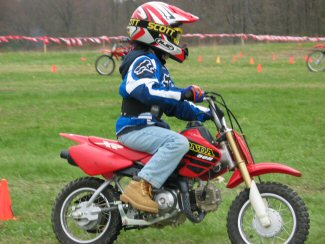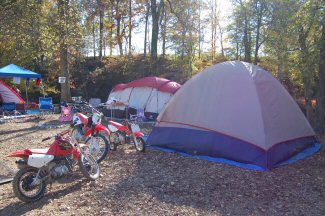| Home > Articles > Helpful Tips For Teaching New Riders |
Helpful Tips For Teaching New Riders
Minimize Your Frustration And Reduce the Chances of Serious Injury
RP Staff (January 2014)Whether you are introducing your child, spouse, or a friend to the sport of trail riding you should first remember that you can't force someone to want to ride, so it is best to wait until after they have expressed a sincere interest in joining you. New riders will crash often and move at a slower pace, so try these tips to help minimize your frustration and reduce the chances of a real motorycle accident with serious injury.
Tip 1 - Buy the right Bike

This is probably one of the most overlooked factors that can help reduce motorcycle injuries and give a new rider the necessary confidence to improve. Not fearing the bike is crucial, and so often, people are taught to ride on a bike that is way too big and powerful for them. Obviously we can't all run out and buy new bikes on a whim, but soon as possible, when you know the person will stick with it, go ahead and spring for that smaller sized bike. Mini sized bikes come with mini sized prices, particularly when used, so it may not be as expensive as you think. When shopping for a bike, base your decision on the height, weight and skill level of the rider. Consider a mellow four stroke such as a CRF150, with a kickstand and an electric start to keep things moving along on the trail. These bikes will slowly claw their way up nasty hills in first gear, so you can start hitting more interesting trails sooner.
Tip 2 - Wear All of your Gear All of the Time
This goes for all riders, really, because you need to set a good example and push the notion that wearing all of your gear is cool. Most of the serious motorcycle accident you hear about involve riders who were not wearing a helmet, or boots, or other essential gear. Usually this is because they were just “warming up the bike” or fooling around or going for a quick spin. The fact is, this is how most accidents and injuries occur. If you wear all your gear all of the time, pretty soon you won't feel comfortable without it, and that's a good thing.
Tip 3 - Use Plastic Motocross Hand Guards
When a rider falls, especially a new rider who falls awkwardly and frequently, the brake and clutch lever will often break. To help minimize this annoyance, you can install plastic hand guards. The plastic ones are cheaper and provide plenty of protection. Avoid the metal reinforced rally bars for new riders, as they do tend to bend during a crash and stay bent, blocking the movement of the levers. You'll find yourself constantly having to detach one side of the guard and bend it back out, which is just as much work as replacing the lever in the first place. Even with the guards, it's a good idea to bring an extra set of levers, plus some simple tools to help replace them. Experienced riders can make do with the stub if a lever breaks, but new riders already have enough to think about.
Tip 4 - Teach Proper Riding Position
One of the most often overlooked aspects is to teach the new rider good body position from the beginning. As soon as they get the hang of the controls, start correcting body position so they develop good habits. They will progress much faster, and therefore have more fun. Bad riding position is very hard to overcome later on.
Tip 5 - Teach Them How to Fall

One of the first things they'll teach you in martial arts, football, or any other contact sport is how to fall. Spend some time with the new rider talking about crashes and accidents, and explain to them the most common ways the bike will go down. You can boil most crashes down to high-sides, slide-outs, endos, and looping. Take a few moments ahead of time to teach them what causes each type of crash, and how to get off and get away from the bike. Also teach them to relax and go limp in the air during a fall and let the gear do it's job, stressing that most injuries occur by trying to save it, or stiffening up while trying break the fall. Have them dive and roll around in the dirt a bit with their gear on (yes really!). It will give them more confidence that the gear is going to protect them. It's also a good idea to have them warm up their muscles a bit then stretch out before the ride, to reduce the risk of injury. It's not a bad idea to make this a part of your regular riding routine.
Tip 6 - Bring Some Basic First Aid
Carry some aspirin or some sort of painkiller, and some band-aids because they WILL get blisters on the first ride. Furthermore, the new rider might take a nasty fall and need something to help dull the pain if it's a long ride back to the staging area and a long drive home. Remember that the first few rides are when they make up their minds about the sport and you want them to have a good first experience. There is plenty of time to toughen them up later, but you won't get the chance if they never want to go again.
Tip 7 - Don't Make Them Ride Beyond their Abilities
For young riders, this is probably the most important tip, if you want them to stick with it. As the teacher, you really have to be aware of the difficulty of the terrain. It's easy to forget the REAL technical requirements and difficult portions of a trail, especially one that you have ridden many times. Take trails that are easy enough for them to enjoy some success. If you make it too hard, too soon, they will end up hating the sport. Always scope out the trail first, and skip the sections that are too challenging. There is plenty of time for that later, but first they need confidence. Once they have that, they will start to search for more difficult terrain on their own. Make sure not to demean their accomplishments. (Three inches of air off that bump IS pretty cool, wow! - You're getting better fast.) Conversely, for mature students such as co-workers, spouses, or other adults, you'll want to present some reasonable challenges before the day ends. That's when they get very quiet, stop listening to you, and get into the zone. That determined look on their face usually means you have tapped the warrior inside, and you might as well call the motorcycle dealer now and tell them you're coming.
Tip 8 - Don't Group Ride Too Soon
During a group ride, a new rider can become quite frustrated and embarrassed because they perceive themselves as holding up the group. Even though the group is very sympathetic, having been there themselves, the new rider may still feel pressured. Helpful tips from too many different people at once will just make them feel worse. For this reason, you should teach the rider in a one-on-one fashion or with a group of beginners until they are more comfortable.
Finally, it should be noted that it can be quite frustrating to you as well when teaching a new rider. After a failing to conquer a difficult section or after a few crashes in short succession, some riders get so flustered they can no longer listen to your instructions, causing you to lose your patience. When this happens, even the nicest, calmest, gentlemanly fathers can turn into raging gorillas on the trail. This level of frustration is really pretty dangerous, both to your health, and for the rider's ego, so make sure you allow yourself other ways to vent. You could take a fast loop alone, or hike up a hill, but if you get to the point of yelling and screaming, it is certain that nothing more will be learned that day. If that happens just head back to camp, grab a cold drink, and focus on the barbecue. Good food makes everything better.






